You may recall that six months ago the market consensus was that central banks would start cutting interest rates and that they would do so aggressively as inflation was expected to contract considerably. Expectations were high that the US Federal Reserve would make at least six rate cuts over the course of 2024.
While the direction of interest rate moves is still expected to be downward, the quantum of the moves has been scaled back considerably, with only 1.5 interest rate cuts by the US Federal Reserve currently priced in. In fact, a number of other central banks have already announced a cutting cycle with the European Central Bank, Canada, Sweden, Switzerland and Hungary being amongst the cadre.
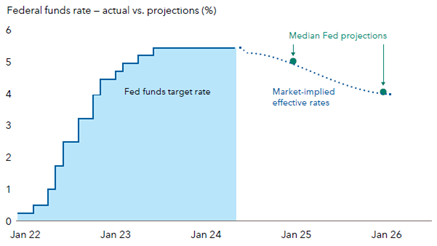
Source: Capital Group
Unfortunately, there is still no clear answer as to whether the US economy will reaccelerate, achieve a soft landing or whether its headed for a recession (hard landing). Previously we had expected a recession in the US and have been surprised by the economic resilience.
We now believe that the most likely outcome is a soft landing but there remains a distinct possibility that a moderate recession could still eventuate. We are starting to see some economic weakness creep into the US economy with higher jobless claims, lower wage growth, lower housing construction and early signals consumption slowing.
The difficulty in trying to determine the most likely economic outcome is that these early signals could simply be highlighting that the economy is cooling, as you would expect to see under a soft-landing scenario. Conversely, if these signals gather momentum, they could be a precursor to a recession. At this stage, it’s too early to warrant a recession call.
The resilience in the US is counterbalancing weakness in Europe and China as highlighted in the following chart Capital Group.
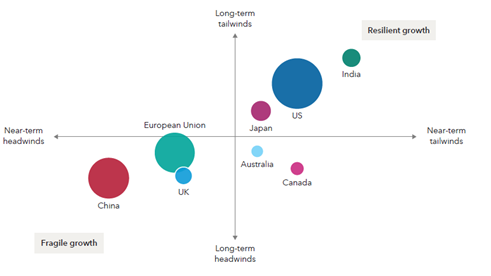
Importantly, while economic output has been soft throughout Europe, there are early green shoots in European GDP forecasts as industrial production picks back up. The United Kingdom is also showing signs of a tentative turnaround though persistently high inflation is holding back the Bank of England. At the same time China appears to be stabilising its economy.
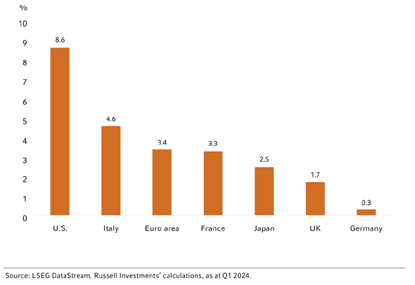
Outlook for corporate earnings
Corporate earnings in the US have been strong with S&P 500 companies, on average, showing year over year growth of 11% in quarter 1, 2024.

Source: Capital Group
The US numbers in the chart above have been swayed by the earnings and valuations of the Magnificent Seven tech stocks whose earnings increased by over 50% year on year compared to the next 493 companies in the S&P 500 who only saw earnings growth of 3% year on year.
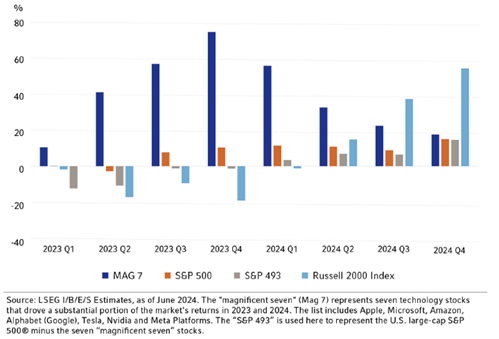
If a soft landing is achieved and interest rates are reduced to reflect this rather than an impending recession, then small companies are best placed to achieve both earnings upgrades and share price rebounds given the large discounts that they currently trade at.
Inflation
Globally, inflation has been trending down leading to the interest rate cut predictions. While it has been trending down, it is proving sticky and this is the key reason the quantum of the rate cuts have been scaled back aggressively.
Inflation in Australia is remaining stubbornly high and appears to be lagging the rest of the world by approximately six months. Some analysts are attributing this lag effect to the fact that we came out of the Covid lockdowns six to nine months after the rest of the world. If this is the contributing factor, we should expect to see inflation soften towards the end of this year and early into 2025.
We continue to believe that the Reserve Bank of Australia is reluctant to lift rates again as there are signs that the current rate settings are impacting the economy. Our base case is that they will make the first rate cut between March and May 2025.
Where to from here?
For the defensive component of portfolios we continue to prefer high grade bonds that should benefit from any interest rate cuts. Due to the increasing risk of a domestic rate rise, we have been lowering the average maturity term (duration) of Australian bond holdings.
Generally, we continue to favour growth assets thanks to the resiliency of both corporate earnings and economic growth. It is important to note that simply because markets make all time new highs, it does not mean that markets are overvalued or about to enter a contraction.
The following chart from Capital Group highlights the US S&P 500 index. Each of the green dots represents when the index reached its first new high in more than a year.
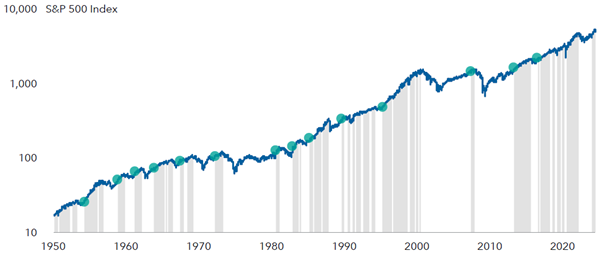
Since 1950 there have been 14 such periods of which 13 have provided a positive return over the next 12 months with an average return of 17.1%.
Andrew Aylward is Chief Investment Officer at Keep Wealth Partners.
For more information contact us on 03 8610 6396
Keep Wealth Partners Pty Ltd (AFSL 494858)
This information is of a general nature only and may not be relevant to your particular circumstances. The circumstances of each investor are different, and you should seek advice from a financial planner who can consider if the strategies and products are right for you.







